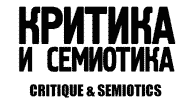The cultural code of the city and the production of space
DOI: 10.23951/2312-7899-2025-2-56-71
The article explores the concept “code of space” proposed by Henri Lefebvre, still little known and rarely encountered in contemporary urban studies, and reveals the role of this code in the process of space production. The author analyzes the concepts “spatial practice”, “representations of space” and “representational spaces”, which are key in Lefebvre’s theory. She shows that spatial practice is associated with the perception of territory, representations of space with comprehension, and representational spaces with experience. At the same time, the production of space, understood as social practice, is also conditioned by three aspects: (1) the action of material forces and technologies, (2) the results of accumulated knowledge, the achievements of science and intellectual thought, and (3) the free process of signification and creation of meanings. The code of space allows us to understand what the produced space communicates, that is, to reach the level of its content and meaning, which means that such a code belongs primarily to the field of representations of space. However, the code of space makes it possible not only to conceptualize a particular space, but also to live in it and to produce it. In other words, the code of space correlates with both experience (representational spaces) and perception (spatial practice). The author argues that the cultural code of the city can be interpreted as one of the variants of the code of space and also demonstrates the existence in modern urban studies of three approaches to the interpretation of the concept “cultural code of the city”: culturological, semiotic and anthropological. The author reviews the main statements of the mentioned approaches and explicates some separate theses, which are poorly coordinated with each other. The article recognizes the need to create an integral method that can take into account the advantages of each of the presented approaches and overcome the existing differences.
Keywords: urban studies, code of space (spatial code), Henri Lefebvre, representations of space, representational spaces, spatial practice, urban semiotics, anthropology of city
References:
Artemenko, A. P., & Artemenko Ya. I. (2020). From postmodernism to metamodernism: The formation of modern visual practices. Tomsk State University Journal of Philosophy, Sociology and Political Science, 58, 47–58. (In Russian).
Augé, М. (2017). Non-lieux, introduction à une anthropologie de la surmodernité (A. Yu. Konnov, Trans.). Novoe literaturnoe obozrenie.
Avanesov, S. S. (2023). Square as a visual pattern of the urban environment. Urbis et Orbis. Microhistory and Semiotics of the City, 3(1), 5–31. (In Russian).
Avanesov, S. S. (2024). City as a cultural project: Principia of humanitarian urban studies. Indrik. (In Russian).
Benjamin, W. (1999). The Arcades Project (H. Eiland & K. McLaughlin, Trans.). Belknap Press.
Fedotova, N. G. (2022). Cultural code of the city. Slovo.ru: Baltic Accent, 13(4), 10–24. (In Russian).
Fedotova, N. G. (2024). Orthodox images in the urban imaginary of Veliky Novgorod. Journal of Visual Theology, 6(2), 368–381. (In Russian).
Foucault, М. (2004). L’archéologie du savoir (M. B. Rakova, A. Yu. Serebryannikova, Trans.). Gumanitarnaya Akademiya, Universitetskaya kniga. (In Russian).
Golovneva, E. V., & Martishina, N. I. (2020). The Cultural landscape as an object of artistic construction: Sakhalin of Anton Chekhov and Ivan Krasnov. Journal of Frontier Studies, 5(3), 32–50. (In Russian).
Gornova, G. V., & Voronin, D. V. (2024). Local identity in urban development: Cultural tools for categorizing meaning. Review of Omsk State Pedagogical University. Humanitarian Research, 1(42), 24–28. (In Russian).
Khan, K. I. (2021). “Topophilia” and “topophobia”: Towards phenomenology of spacial experience. Voprosy Filosofii, 1, 55‒65. (In Russian).
Kopchuk, L. B. (2024). Representation of the cultural code of a city in German and Austrian phraseology. Philology. Theory & Practice, 17(12), 4613–4619. (In Russian).
Lefebvre, H. (1974). La production de l’espace. Anthropos.
Lefebvre, H. (2015). La production de l’espace (I. Staf, Trans.). Strelka Press. (In Russian).
Lotman, Yu. M. (2000). The semiosphere. Iskusstvo-SPb. (In Russian).
Melik-Gaykazyan, I. V. (2016). Tower of Babel as the metaphor of hi-tech dynamics “semiotic attractor”. Philosophy of Science and Technology, 21(1), 92–103. (In Russian).
Merkulova, O. (2024). The Preobrazhensky Market: A mechanism for preserving the bazaar in neoliberal Moscow. Antropologicheskiy Forum, 63, 124–156. (In Russian).
Mitin, I. I. (2022). City as palimpsest: From a metaphor within historical geography towards a semiotic model of place management. Human Being: Image and Essence. Humanitarian Aspects, 1(49), 108–125. (In Russian).
Orlova, N. Kh. (2018). The territory of Children’s Art Genre (from the Anichkov Palace Annals). Paradigma, 29, 150–156. (In Russian).
Plavinskaya, L. S. (2024). Images-symbols of traditional artistic crafts in the formation of the cultural code of the city. Cultural Code, 1, 69–92. (In Russian).
Sapogov, I. A. (2024). Youth Tusovka in urban space: A case of KG (Kitay-gorod). Urban Folklore & Anthropology, VI(4), 62–83. (In Russian).
Schwarze, T. (2023). Space, urban politics, and everyday life. Henri Lefebvre and the U.S. city. Palgrave Macmillan.
Simyan, T. (2022). “Guilty of being free”: An intellectual vs. Soviet penal system (prison letters and drawings of Sergei Parajanov). Changing Societies & Personalities, 6(1), 197–216.
Smirnov, S. A. (2021). City and man: Essays on urban anthropology. Lenand. (In Russian).
Soja, E. (2000). Postmetropolis. Critical studies of cities and regions. Blackwell Publishing.
Tuchina, O. R., & Apollonov, I. A. (2024). Study of value foundations of place identity: A subject approach. Russian Psychological Journal, 21(3), 91–111. (In Russian).
Ukrainskiy, V. N., & Chimitdorzhiev, Zh. Zh. (2022). Henri Lefebvre and the polymorphism of social space. Ojkumena. Regional Researches, 1(60), 61–72. (In Russian).
Vershinina, I. A. (2018). Anri Lefevr: from “the right to the city” to the “urbanist revolution”. Moscow State University Bulletin. Series 18. Sociology and Political Science, 24(2), 48–60. (In Russian).
Zilivinskaya, E. D. (2017). Trade constructions in Oriental and Golden Horde towns. Povolzhskaya Arkheologiya, 4(22), 46–66. (In Russian).
Issue: 2, 2025
Series of issue: Issue 2
Rubric: ARTICLES
Pages: 56 — 71
Downloads: 709










